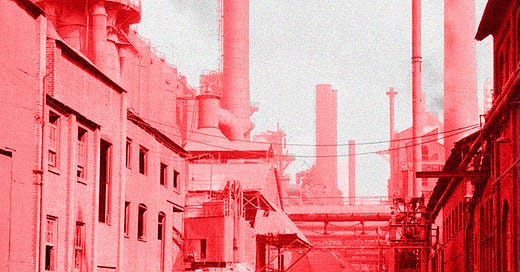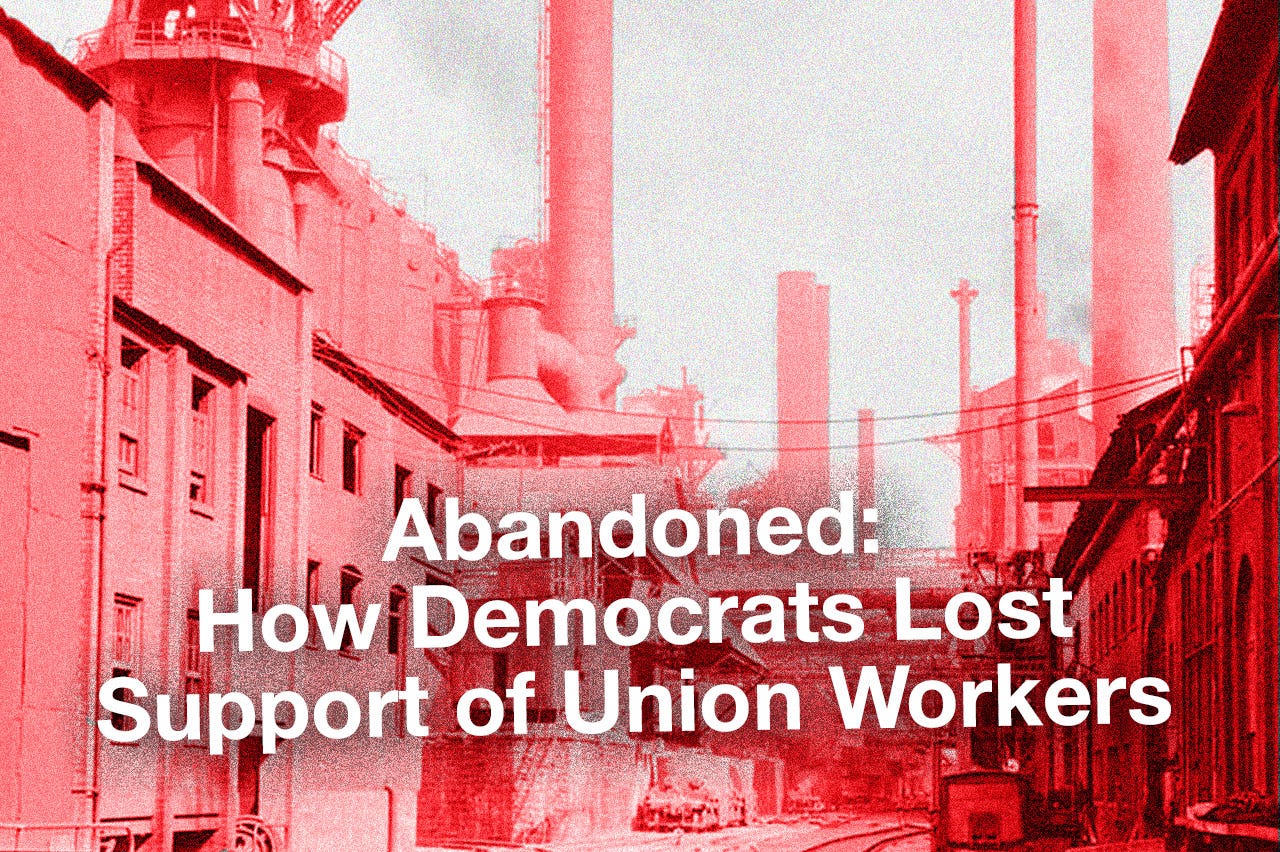How Democrats Lost Support of Union Workers
Democrats have long been accused of abandoning voters. Disillusionment with the party is particularly acute in the Rust Belt, where the long-cracking union wall has collapsed.
It was just before 3 a.m. on Nov. 9, 2016 when the stunning news of Donald Trump’s presidential victory began ricocheting across the globe. Forget whiplash. For some, it felt like they had been instantly teleported to another dimension entirely—one where a reality TV star provocateur and ostensible populist would obliterate political and cultural “norms” and ascend to the most powerful elected office in the world.
Those questioning reality, or their reality, would then cringe as they watched one of the most dystopian speeches of their lifetime. “American Carnage” was delivered at the U.S. Capitol on Jan. 20, 2017. The reeling political establishment, including the media, was crestfallen.
How could Hillary Clinton lose? She was The Chosen One.
Forget that she neglected Michigan and Wisconsin.
Okay, maybe the primary process was rigged—but, c’mon, we couldn’t let the voters decide for themselves who should be the Democratic candidate.
When the fever finally broke, they turned their ire to Russia and other potential villains, including Green Party candidate Jill Stein, who was accused of playing spoiler. Reasonable analyses of Democratic shortcomings faded into the background as accusations of Putin meddling took hold.
For all the air time and ink devoted to everything from Russian bots to blackmail tapes of Trump engaging in unseemly behavior with prostitutes, along with other extraordinary claims, it seems the answer to how Trump won can partly be explained by the erosion, or complete collapse, of the Democrats’ infamous Blue Wall in the Rust Belt.
There was a time when members of the industrial unions that transformed the Rust Belt into a hotbed of civic participation would cringe at the idea of supporting a Republican candidate for office.
In 2016, Trump earned the backing of more union members than any GOP presidential candidate since Ronald Reagan.
Why We Covered This Topic
Over the summer, we came across a book that had just been published, which early reviews suggested provided a clearer picture of Trump’s 2016 win and the collapse of Democratic support among union members. With another election around the corner, and with Trump the likely GOP candidate despite his legal troubles, it seemed necessary to better understand both the collapse of the unionized workforce in the Rust Belt and today’s political realignment.
In “Rust Belt Union Blues: Why Working-Class Voters Are Turning Away from the Democratic Party,” Lainey Newman and Theda Skocpol provide an important historical accounting of the rise and fall of Rust Belt industrial unions and the corporate and geopolitical forces at play.
For their purposes, Newman and Skocpol analyzed historical records, including decades-old union newsletters, and conducted field research and interviews with current and former union workers, the majority of whom live in western Pennsylvania.
Here’s what they wrote:
As of 1952, about 60 percent of union members identified as Democrats, and most of the rest labeled themselves as independents who in practice leaned Democratic. Thus, Democratic Party candidates tended to court and listen to unions that enrolled so many voters open to their party's messages.
Union members not only leaned toward Democrats; they also voted at higher rates than nonunion members. Even in the mid-1950s, when electoral turnout was at a modern high, union membership increased the chances that an individual would go to the polls.
As they write two pages into the book:
As one retiree explained, most blue-collar workers in the mid-twentieth century “figured there wasn’t a Republican in the world who took care of the working guy.” The declared loyalties of the steelworkers and other workers indicated their views about the groups, leaders, and the major political party that seemed committed to them. Worker support went to partners who who workers felt were involved with them—day in, day out, month in, month out. Blue-collar unionists today rarely feel that the Democratic Party is committed to them in that way anymore.
What You’ll Learn in This Episode
At the height of union power, which the authors say was in the 1950s, these organizations were central to community identity. Unions organized community events, people gathered at union halls, and workers who spent days shoulder-to-shoulder became fast friends.
The close-knit connection created a sense of shared identity, which manifested in multiple ways, including in their political choices. For the most part, Rust Belt union members were exclusively Democratic supporters and engaged voters. As the authors note: “In the mid-twentieth century, union membership was a good predictor of blue-collar voting behavior, and as recently as twenty years ago, more highly unionized counties in Rust Belt states were more likely to deliver majorities for Democratic candidates in presidential years.”
Union Democratic support was not necessarily the product of organizational leaders dictating how to vote, but the decisions were based on their collective identity.
As steel and other industries collapsed due to a variety of factors, the power of the unions, especially their role a hub for civic and community engagement, collapsed. Union halls, which were all over the region, were replaced by gun halls, the NRA, and later, Tea Party involvement. The decline of union power also coincided with a more political NRA. That’s important to note because many of the union members who historically supported Democrats were even then gun enthusiasts and hunters—yet they still voted Blue.
Union members interviewed for the book felt a sense of abandonment by the Democratic Party, which they saw as catering almost exclusively to big cities. This passage from the book sums it up:
Much of the growing disconnect between Democrats and remaining industrial unionists comes from frayed local union and party ties along with new links to community-based conservative networks. In turn, such shifts in community ties encourage changes in shared identities, worldviews, and beliefs about social and political friends and foes. After Tea Party ideas, Trump, and Trumpism moved to the fore in GOP politics, messaging about the out-of-touch nature of the Democrats became even more explicit and emotionally resonant. Regardless of this or that issue stand, Democrats are often seen as aloof, absent, and threatening to workers, especially those outside big metropolitan areas.
Worker-citizens who feel overlooked or abandoned—or worse, looked down on—become open to messages from the right that their real political enemies are no longer economic elites but instead are liberals or the so-called radical left Democrats.
Who We Interviewed & What They Said
Lainey Newman co-authored “Rust Belt Union Blues: Why Working-Class Voters Are Turning Away from the Democratic Party.” Newman, who is from Pittsburgh, is a second-year law student at Harvard Law School.
“The conclusion that we come to—this was mainly provided through the interviews that we conducted—it came down to sort of a sense of group identity. So I heard from many retirees, essentially something along the lines of, you know, there's never been a Republican who has looked out for the working man, or, you know, union guys just don't vote for the Republicans, they're on the side of the rich, they're on the side of the wealthy. That type of posturing of us versus them, I think, was really central to the connection between unions on the local level and on the community level, with unions on the political level.”
Additional Resources
Pick up “Rust Belt Union Blues: Why Working-Class Voters Are Turning Away from the Democratic Party.” It’s a must-read for anyone trying to understand changing political allegiances and the decline of unions over the last few decades. It’s especially important today considering the rise in union and strike activity, with workers from Amazon and Starbucks, specifically, bringing the issue to the fore. The recent strikes from the United Auto Workers (UAW) underscore what can happen when working-class people stand up against corporate greed.
Here’s the episode we mentioned in the outro called “Abandoning the Left.” It features Jill Stein, Chris Hedges, and Richard Wolff.
News Beat is a multi-award-winning podcast brought to you by Hypha HubSpot Development and Manny Faces Media.
Audio Editor/Sound Designer/Producer/Host: Manny Faces
Editor-In-Chief/Producer: Christopher Twarowski
Managing Editor/Producer: Rashed Mian
Episode Art: Jon Chim







Two great new book reads on Amazon following changing lives forever if you believe in second chances.